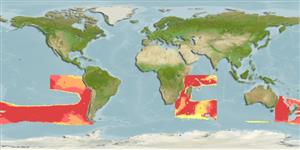Classification / Names
Noms communs | Synonymes | Catalog of Fishes(Genre, Espèce) | ITIS | CoL | WoRMS | Cloffa
>
Lophiiformes (Anglerfishes) >
Gigantactinidae (Whipnose anglers)
Etymology: Gigantactis: Greek, 'gigas' or 'gigantos' = gigantic + Greek, 'aktis' = ray (referring to the unusually long first dorsal-fin spine that functions as a lure in this genus) (Ref. 86949).
Environment: milieu / climate zone / depth range / distribution range
Écologie
marin bathypélagique; profondeur 1850 - 2000 m (Ref. 86949). Deep-water
Southeast Pacific: Chile (Ref. 9068).
Taille / Poids / Âge
Maturity: Lm ? range ? - ? cm
Max length : 28.8 cm SL mâle / non sexé; (Ref. 58502)
Description synthétique
Morphologie | Morphométrie
Rayons mous dorsaux (Total): 6; Rayons mous anaux: 6. Metamorphosed females distinguished by the following characteristics: have filaments on dorsal surface of head just behind base of the illicium; length of illicium less than 120% SL (72-96% SL); presence of short filaments along entire posterior margin of illicium; escal bulb with an elongate spinulose and darkly pigmented distal prolongation bearing distally flattened papillae; presence of short distal and slender proximal escal filaments; absence of posterior pair of close-set illicial appendage; relatively long dentary teeth (longest 2.9-3.8% SL) in five or six longitudinal series; short caudal fin rays (less than 30% SL) (Ref. 86949).
Life cycle and mating behavior
Maturité | Reproduction | Frai | Œufs | Fécondité | Larves
Pequeño, G., 1989. Peces de Chile. Lista sistematica revisada y comentada. Rev. Biol. Mar., Valparaiso 24(2):1-132. (Ref. 9068)
Statut dans la liste rouge de l'IUCN (Ref. 130435)
Menace pour l'homme
Harmless
Utilisations par l'homme
Plus d'informations
Noms communsSynonymesMétabolismePrédateursÉcotoxicologieReproductionMaturitéFraiRassemblement de ponteFéconditéŒufsDéveloppement de l'œuf
Taille/ÂgeCroissanceLongueur-poidsLongueur-longueurFréquences de longueursMorphométrieMorphologieLarvesDynamique des populations larvairesRecrutementAbondanceBRUVS
RéférencesAquacultureProfil d'aquacultureSouchesGénétiqueElectrophoresesHéritabilitéPathologiesTraitementNutrientsMass conversion
CollaborateursImagesStamps, Coins Misc.SonsCiguateraVitesseType de nageSurface branchialeOtolithesCerveauxVision
Outils
Articles particuliers
Télécharger en XML
Sources Internet
Estimates based on models
Preferred temperature (Ref.
123201): 2 - 2.8, mean 2.4 °C (based on 66 cells).
Phylogenetic diversity index (Ref.
82804): PD
50 = 0.5000 [Uniqueness, from 0.5 = low to 2.0 = high].
Bayesian length-weight: a=0.01995 (0.00906 - 0.04395), b=3.01 (2.83 - 3.19), in cm total length, based on all LWR estimates for this body shape (Ref.
93245).
Niveau trophique (Ref.
69278): 4.2 ±0.7 se; based on size and trophs of closest relatives
Fishing Vulnerability (Ref.
59153): Low to moderate vulnerability (25 of 100).
